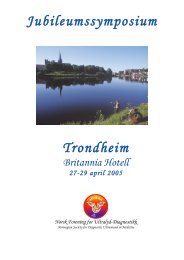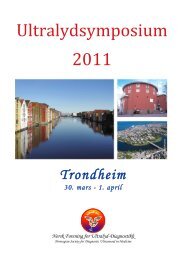Ultralydsymposium - NORSK FORENING FOR ULTRALYD ...
Ultralydsymposium - NORSK FORENING FOR ULTRALYD ...
Ultralydsymposium - NORSK FORENING FOR ULTRALYD ...
- No tags were found...
You also want an ePaper? Increase the reach of your titles
YUMPU automatically turns print PDFs into web optimized ePapers that Google loves.
Limitations of the ultrasound scannerR. Hansen 1,21) Dept of Medical Technology, SINTEF Technology and Society, 2) Dept of Circulationand Medical Imaging, NTNUBACKGROUNDUltrasound images are based on echoes resulting from variations in the material parametersmass density and bulk compressibility of the object being imaged. With large variations inthese material parameters, as found at interfaces between soft tissue and bone or soft tissueand gas, most of the transmitted ultrasound wave is reflected at the interface resulting inshadows behind such interfaces.Two image parameters are especially important for the quality of an ultrasound image 1)Spatial resolution: The ability to separate and image small objects and 2) Contrastresolution: The ability to separate and image strong and weak objects.Reconstruction of medical images from back-scattered ultrasound echoes are based onsome acoustical assumptions that often are not fulfilled. In many practical imagingsituations, image quality suffers due to these assumptions.One assumption is that the ultrasound waves are propagating with a constant speedof sound. Many organs show small variations in the speed of sound and the indicatedassumption is then good within the organs. However, the body wall shows larger variationsin the speed of sound resulting in aberrations of the acoustic wave-fronts. A variable soundspeed along the propagating wave-front destroys the transmit and receive beams resultingin reduced focusing of beam main-lobe and increase in beam side-lobes. The reducedfocusing of the beam main-lobe reduces the spatial resolution in the ultrasound image. Theincrease in beam side-lobes introduces additive noise in the image, reducing thecontrast resolution in the image.A second assumption is that multiple scattering is neglected. For many organs, thisapproximation is good. For the body wall, where larger variations in material parametersare found, this assumption is often inadequate. Interfaces between soft tissue componentswith significant differences in material parameters, such as muscle and fat in the bodywall, give so strong echoes from the transmitted acoustic pulses that multiple scattering getsignificant amplitudes. Such multiple scatterings are termed pulse reverberations. Thesepulse reverberations reduce the contrast resolution in the ultrasound image. Reducedcontrast resolution is a problem when imaging hypo-echoic structures such as the heartchambers, the lumen of large blood vessels, some atherosclerotic lesions and tumors, cystsas well as in fetal diagnosis.Even without reduced contrast resolution due to multiple scattering and wave-frontaberrations, there is in some situations limited image contrast between healthy andpathological tissue and between benign and malignant pathological changes. Imagecontrast may then be increased by adding ultrasound contrast agents to the blood forassessment of the micro-circulation within the object of interest.











